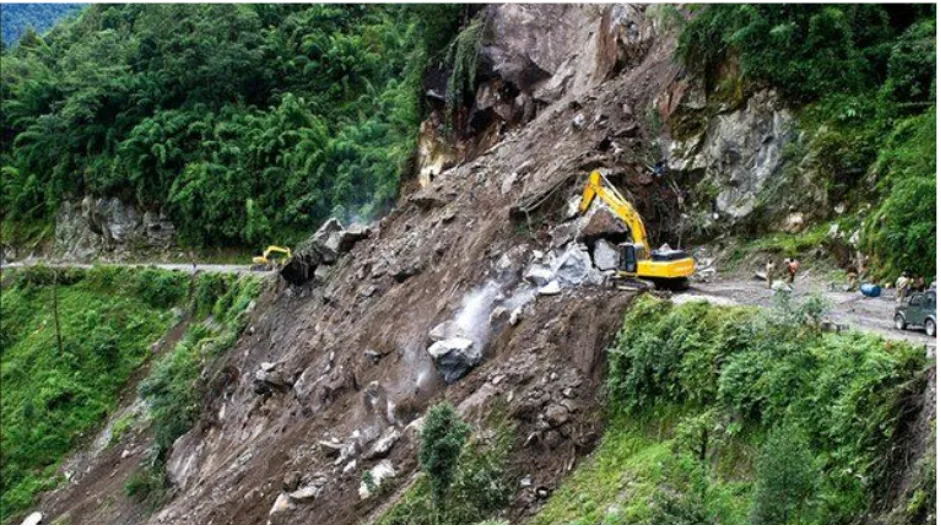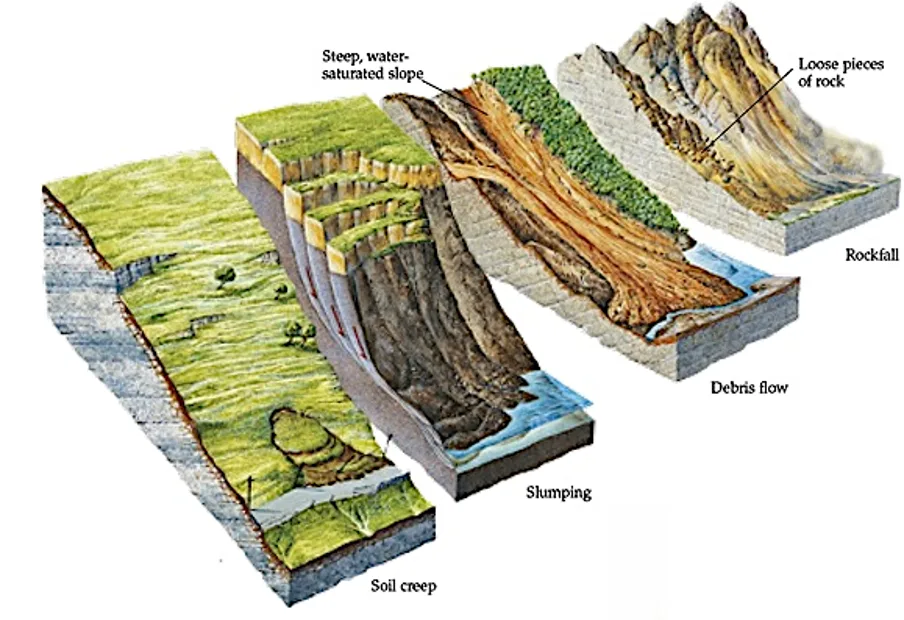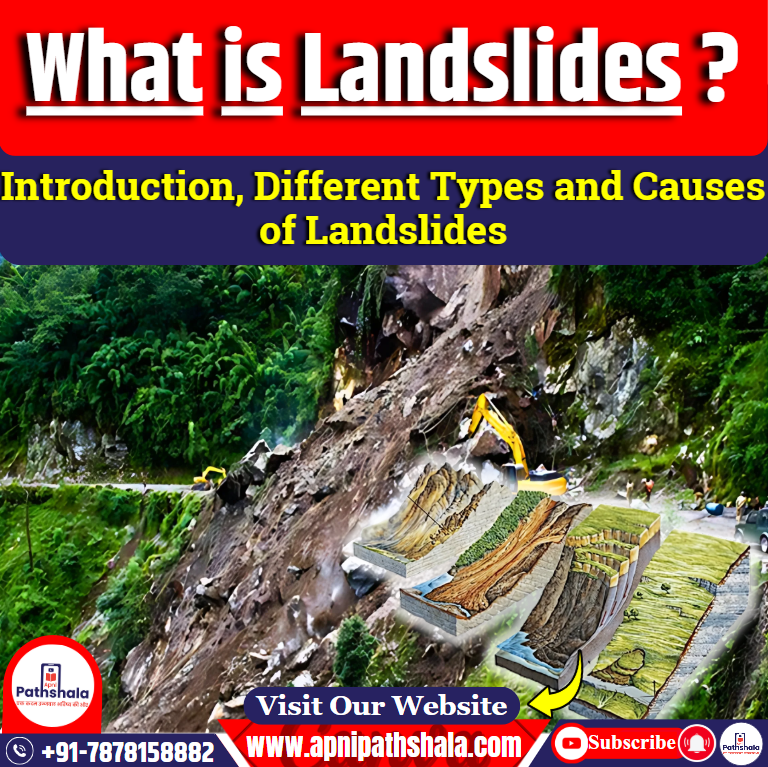
What’s in this Article?
- Table of Contents
- Introduction
- What is Meant by Landslide?
- Different Types of Landslides
- Causes of Landslides
- Introduction
Landslides: Are also referred to as landslips. It encompass diverse types of mass wasting involving ground movements like rockfalls, mudflows, and slope failures.
They manifest in various environments, featuring steep or gentle slope gradients, ranging from mountain ranges to coastal cliffs. Additionally, landslides can occur underwater, known as submarine landslides.

What is Meant by Landslide?
- A landslide is the movement of rock, earth, or debris down a slope, occurring either abruptly or gradually over an extended duration. The occurrence of a landslide results from the force of gravity surpassing the resisting forces of a slope.
- Various external factors contribute to landslides, such as: Intense rainfall causing ground saturation, Erosion at the base of a slope and Changes in material strength due to weathering .
Different Types of Landslides:

- Rock Falls: Rock falls are the most common and easily identifiable type of landslide. They occur when individual rocks or boulders detach from steep slopes and freefall to the base.
- These landslides often happen due to weathering, seismic activity, or erosion. The falling rocks can cause significant damage and pose a direct threat to human life and infrastructure in their path.
- Slides: Slide-type landslides involve the movement of a cohesive mass of rock or soil along a well-defined failure plane. Slides typically occur on slopes with weak layers of rock or soil that fail under the influence of gravity and other factors.
- They can be further classified into rotational slides, translational slides, and compound slides based on the movement pattern.
- Rotational Slides: Also known as slumps, rotational slides involve the downward and outward movement of a mass along a curved failure plane.
- These landslides typically occur in cohesive materials, such as clay or silt, where the failure plane is curved due to the rotational movement.
- Translational Slides: Translational slides occur when a mass moves along a planar failure surface parallel to the slope.
- They often happen in areas with weak or saturated soils, such as clay or silt, where the failure plane is relatively flat.
- Compound Slides: Compound slides exhibit characteristics of both rotational and translational slides.
- They involve complex movement patterns, with portions of the mass moving along curved surfaces and others along planar surfaces.
- Flows: Landslides categorized as flows involve the movement of a mass of unconsolidated material, such as soil, mud, or debris, down a slope.
- Flows are typically triggered by heavy rainfall, snowmelt, or volcanic activity. The three main types of flow landslides are:
- Debris Flows: Debris flows consist of a mixture of soil, rock fragments, water, and organic material. They often occur in mountainous regions and can move at high velocities, resembling fast-flowing rivers.
- Debris flows are highly destructive due to their ability to carry large volumes of material and debris.
- Mudflows: Mudflows, also known as mudslides, are similar to debris flows but contain a higher proportion of fine-grained materials, such as clay and silt.
- They often happen in areas with abundant rainfall or in regions recently affected by wildfires, where the vegetation has been stripped, and the soil is more susceptible to erosion.
- Lahars: Lahars are specific types of mudflows that are triggered by volcanic activity. They result from the mixing of volcanic ash, debris, and water, forming a fast-moving slurry that can travel long distances from the volcano’s source.
Lahars pose a significant threat to communities located near active volcanoes.
Complex landslides:
- Complex landslides are a combination of two or more landslide types, making them particularly challenging to study and predict.
- These landslides often involve a sequence of movements, including rock falls, slides, and flows, occurring simultaneously or in rapid succession.
Complex landslides can cause widespread devastation and are more difficult to mitigate due to their multifaceted nature.
Causes of Landslides
- Landslides can occur due to a variety of factors, both natural and human-induced.
- Understanding these causes is crucial for comprehending the occurrence and distribution of landslides across different regions. Natural Causes of Landslides Landslides triggered by natural forces often stem from geological and environmental factors.
- Here are some significant natural causes:
- Rainfall: Heavy or prolonged rainfall can saturate the ground, increasing pore water pressure and reducing soil stability. The excess water weakens the slope, leading to landslides.
Slope and Geology: Steep slopes, weak rock formations, or layered soils can contribute to slope failure. When the gravitational force acting on a slope overcomes its stability, landslides occur.
- Earthquakes:
- Ground shaking during earthquakes can destabilize slopes by adding stress or triggering existing weaknesses, causing landslides.
- Human-Induced Causes of Landslides Human activities can significantly impact the occurrence and magnitude of landslides.
- Here are some key human-induced causes: Deforestation: Clearing of vegetation weakens slopes, removing the root support that holds the soil together.
- This makes the slopes more susceptible to landslides.
- Construction and Excavation: Altering slopes through construction activities or excavation can disrupt natural stability, altering the balance of forces and increasing the chances of landslides.
- Irrigation and Drainage: Poorly designed irrigation systems or inadequate drainage can alter the groundwater regime, resulting in increased pore pressure and slope instability.
- Effects of Landslides: Landslides can have far-reaching impacts on various aspects, including human lives, infrastructure, and the environment.
- Understanding these effects is essential for formulating effective disaster management strategies. Societal and Economic Impacts Landslides can bring about significant social and economic consequences, such as:
- Loss of Life and Injuries: Landslides pose a direct risk to human life, causing fatalities and injuries, particularly in densely populated areas or regions with inadequate infrastructure.
- Displacement and Migration: Displaced populations face the challenges of relocation, loss of livelihoods, and disruption of social ties, requiring long-term rehabilitation efforts.
- Economic Losses: Landslides damage or destroy buildings, roads, and other infrastructure, resulting in substantial economic losses for communities and governments.
- Environmental Consequences Landslides also have ecological repercussions and can adversely impact the environment.
- Loss of Vegetation: Landslides often strip away vegetation cover, exposing the soil to erosion and reducing biodiversity.
- This can lead to long-term ecological degradation. Soil Erosion and Sedimentation: Sediments from landslides can clog rivers and water bodies, disrupting aquatic ecosystems, and increasing the risk of floods downstream. Habitat
- Destruction:
- Landslides can obliterate natural habitats, displacing or endangering wildlife populations and disrupting fragile ecosystems.
Disclaimer: The article may contain information pertaining to prior academic years; for further information, visit the exam’s “official or concerned website”.
Explore our courses: https://apnipathshala.com/courses/
Explore Our test Series: https://tests.apnipathshala.com/










